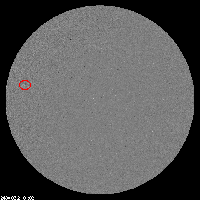|
|
Hinode (Sunrise), a project to study the Sun, is exploring
the magnetic fields of the Sun, and is improving our understanding of the mechanisms that power the solar atmosphere and drive solar eruptions.
|
|
A New Cycle Ephemeral Region!
Aug 21, 2008
|

|

|
Conditions on the Sun continue to be quiet; however, a new cycle ephemeral region has appeared in the northern hemisphere (N15E57 at 07:00 UT on August 21) adding more area by 06:00 UT on August 22.
An ephemeral region is a small magnetic dipole that appears on the disk of the Sun that may or may not develop into a sunspot group.
The image on the left above, is a magnetogram from SOHO's MDI. The image on the right is from Hinode's X-ray Telescope (XRT). Based on the magnetic configuration (negative polarity leading in the northern hemisphere), the marked ephemeral region is a part of the new sunspot cycle of the Sun, cycle 24. On May 5, AR 10993, new cycle sunspots made an appearance in the southern hemisphere.
The Sun is very quiet, as seen in X-ray data from Goes 10. Since June 15, X-ray flux has been less than or equal to 1 x 10-8 Watts/m2.
|
More Quiet Time on the Sun
June 24 - July 8, 2008
|

|
The movie above is a compilation of X-ray images from June 24 to July 8, 2008. The loops close to the equator on June 24-26 (to the right of the central meridian) are from old-cycle spots, NOAA active region 10999 (AR 10999). The Sun continues to show little activity and has produced only one B-class flare in the time period May 17 - July 11 (as seen by GOES ). For an explanation of flare classes, go to Space Weather's Classification of X-ray Solar Flares.
New cycle spots in the southern hemisphere will appear with positive polarity on the western (right) side of the sunspot. For new cycle spots in the northern hemisphere, the reverse is true (negative polarity to the west). Compare AR10999 with the southern hemisphere new cycle spot of 6 May, 2008. The solar surface (photosphere) has has had only two numbered spots June 11 - July 11, 2008 (see the Solar Monitor).
|
|






